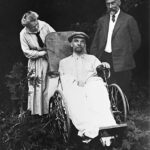
His stare is almost reflective of his life. Scary, altering, and piercing, Lenin looks through the camera as he is pictured here in his last photo before death. The man behind what we now know as communism today, Lenin rose to fame through his far-left revolution in Russia which toppled the Czarist regime and led Lenin to implement Marxist values in the country. Creating the USSR, Lenin is known as one of the most influential political figures of the 20th century. Despite this, Lenin’s demise is still clouded in mystery.
What is clear, Lenin was a troubled and unhealthy man when he eventually died in 1924. It seems the stress of his turbulent life had led him to an early demise. But what eventually killed him is still debated by historians. The main theory that many believe to be the case is following an attempted assassination of Lenin in 1918 which he survived, reflecting his courage to fellow countryfolk, really changed him. It would be this alongside his continual work towards the USSR effort that would be his downfall.
Two bullet wounds from the assassination attempt had an apparent mental effect combined with his strenuous 15 hour a day work ethic led Lenin to suffer from 3 strokes. It would be these three strokes which would leave Lenin in the state displayed in this picture. Relentless in their nature, like the Bolsheviks revolutionising Czarist Russia, the strokes continually hit Lenin, debilitating him more and more each time. A sad way to go for such a poignant figure.
A searching stare, the mute and paralysed Lenin looks a shadow of his former, formidable self in this 1923 snap. With his sister and doctor by his side, he had become weary and desperate, yet tried his best to remain engaged with politics throughout his lifetime, even after his strokes. Despite many claiming it was the attempt at his life and work balance which brought about his ultimate streak of strokes, there has been recent controversy surrounding this.
Recent historians have argued that they believe that Lenin suffered from syphilis, with evidence from important figures at the time who couldn’t voice these concerns due to the regime. Helen Rappaport is the biggest advocate for this opinion, which she suggests is apparent. Furthering on controversy surrounding Lenin’s death, others assume his eventual demise was linked to his previous diagnosis of St Anthony’s Fire, which he had suffered from earlier in his life. Perhaps, the mystery around this man’s life is but a reflection of his turbulent and ever-changing life.
Lenin would die following his 3rd stroke, not even a year after this picture was taken. His success as a leader would be reflected in his funeral. Embalmed and displayed for all of the USSR and the world to see, Lenin was laid to rest in an open casket then later placed in a mausoleum on the Red Square in Moscow. St Petersburg would later be named Leningrad and one million people paid their respects during the state funeral put on for Lenin. Turned to ice and having his brain examined well past his death would be yet another quirky tale in this man’s emphatic existence.
The final photograph taken of Vladimir Lenin.
He is seen with his sister Anna Ilyinichna Yelizarova-Ulyanova and his doctor A. M. Kozhevnikov in Gorki in May 1923. Wikimedia Commons // Public Domains










Leave a Reply